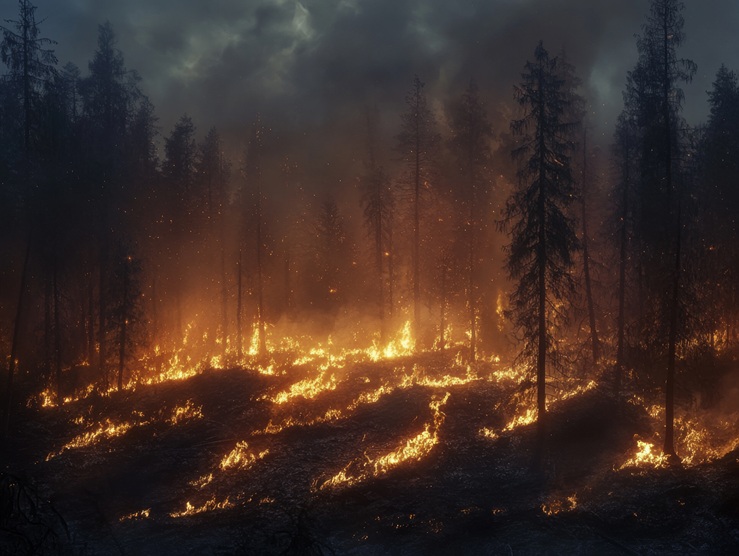Natural Disasters and Infrastructure Resilience: A Critical Issue for Real Estate and Communities
As natural disasters intensify due to climate change and rapid urbanization, infrastructure resilience has become a global priority. Risks associated with floods, wildfires, earthquakes, and other extreme climatic events have exposed the vulnerability of buildings and territories. This situation necessitates a holistic approach to protect populations, preserve real estate assets, and mitigate economic and social impacts.
Strengthening Buildings Against Climatic Risks
Buildings, whether residential, commercial, or public, must be designed to withstand increasingly extreme climatic and geological conditions.
Floods
Adapted construction techniques: Buildings in flood-prone areas now incorporate raised foundations, watertight walls, and reinforced drainage systems to quickly evacuate water. Water-resistant materials: Use of non-porous materials for flooring, walls, and electrical installations minimizes damage during floods. Physical barriers: Installation of levees, flood walls, and pumping systems in urban areas to reduce exposure to floodwaters.
Wildfires
Structural prevention: Buildings in wildfire-prone areas are constructed with fire-resistant materials, such as metal roofs, heat-resistant glazing, and non-combustible exterior cladding. Buffer zones: Creation of "defensible spaces" around properties, with landscaping designed to limit natural fuels such as trees and brush. Alert and suppression systems: Deployment of connected smoke detectors, automatic sprinklers, and water reservoirs to ensure rapid response in case of fire.
Earthquakes
Seismic codes: Seismically active regions enforce strict building codes requiring structures capable of withstanding tremors, including reinforced foundations and flexible designs to absorb vibrations. Innovative techniques: Implementation of technologies like seismic isolators, which reduce the forces transmitted to buildings during an earthquake. Upgrades and compliance: Retrofitting older infrastructure to meet modern seismic safety standards.
Rising Insurance Costs and Regulations in High-Risk Areas
Increased exposure to natural disasters has led to significant changes in insurance policies and real estate regulations.
Enhanced Insurance Coverage
Higher premiums: Insurers are adjusting premiums to reflect the growing severity of risks in certain areas, particularly for floods and wildfires. Mandatory coverage: Governments in some regions require natural disaster insurance to protect homeowners from financial losses. Parametric insurance: Innovative solutions based on objective triggers, such as wind speeds or rainfall levels, enable quick payouts following a disaster.
Stricter Regulations in Risk Zones
Restrictive zoning: Urban planning increasingly prohibits or limits construction in areas deemed too dangerous, such as floodplains or unstable slopes. Local resilience plans: Municipalities are mandated to create risk prevention plans (PPR) to map vulnerable areas and enforce construction rules tailored to those risks. Mandatory retrofits: In certain regions, property owners are required to upgrade buildings to comply with safety standards, including seismic and fire-resistant measures.
Sustainable Urban Planning to Minimize Disaster Impacts
Beyond individual buildings, a comprehensive approach to sustainable urban planning can reduce the systemic vulnerabilities of cities to natural disasters.
Managing Hydraulic Risks
Green infrastructure: Implementation of retention basins, wetlands, and urban parks capable of absorbing rainwater to reduce flooding. Restoration of waterways: Re-naturalizing rivers and removing rigid canal systems to restore natural floodplains and mitigate overflow risks.
Resilient Urban Design
Eco-districts: Development of neighborhoods incorporating green buildings, renewable energy, and waste and water management systems. Distributing essential infrastructure: Avoiding the concentration of critical facilities such as hospitals, schools, and power grids in high-risk zones ensures functionality during crises.
Mitigating Urban Heat Islands
Greening initiatives: Planting trees and creating green roofs to lower urban temperatures, which exacerbate the impact of heatwaves. Reflective materials: Use of heat-reflective materials for roads, sidewalks, and building facades to reduce heat absorption.
Stakeholder Involvement
Infrastructure resilience requires close collaboration among various stakeholders:
Governments: Developing public policies and financial incentives to support resilient projects.
Private sector: Investing in innovative technologies and integrating sustainability criteria into real estate projects.
Citizens: Raising awareness and educating communities about precautionary measures and upgrades to reinforce their homes.
A Global Economic and Social Challenge
Natural disasters cause billions of dollars in damage annually, impacting both property and human lives. Investing in resilient infrastructure not only reduces these costs but also enhances the safety of communities and protects local economies. By designing cities better equipped to handle climatic and natural challenges, the real estate sector plays a direct role in building a safer, more sustainable, and equitable future.

